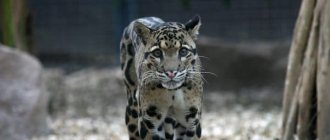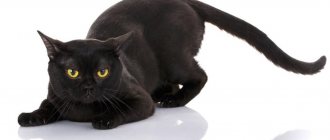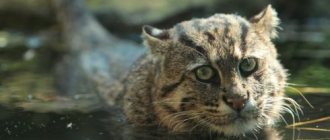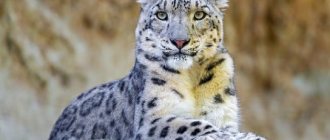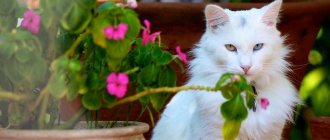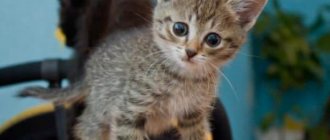Description of panthers
Panther
Panther belongs to the genus of large predatory animals from the cat family.
This genus is represented by four living all known predators: tiger, leopard, lion and jaguar. The panther is none other than a representative of the leopard (read our article: the biggest cats in the world). Although there is still controversy over who exactly the panther belongs to, jaguars or leopards. Panthers are distinguished because of their color, because many of them have an even color, most often black. Interesting fact : due to its majestic appearance, the panther was used on the emblem of English kings. Nowadays it is present on the coat of arms of the African country of Gabon.
What is the name of the panther from Mowgli?
Bagheera is a black panther, a fictional character from Rudyard Kipling's The Jungle Book and The Second Jungle Book.
Interesting materials:
What wall color maximizes space? What flower does Scorpio need? Which Turkish series should I watch reviews? What is the specific gravity of diesel fuel? What angle in degrees does the hour hand of a clock travel in 30 minutes? Which layer of the TCP IP model provides communication between subnets that form a composite network? What kind of harvest does one apple tree produce? Which option is not a phrase? How much weight can you put on a washing machine? What type of conductivity is provided by the acceptor impurity?
Appearance of panthers
Appearance of panthers
These wild animals have a muscular body, which reaches a length of 95-180 cm, a tail - 70-115 cm. The weight of panthers usually ranges from 40-55 kg, but some individuals can reach 100 kg. The tail accounts for up to half the length of the body, sometimes more; thanks to this assistant, they maintain excellent balance and feel comfortable even at high altitudes. Panthers are very graceful animals, but behind their external beauty and grace lies a real ruthless predator that can easily attack a person.
Wool
The fur of these animals is hard, it covers the entire body and most often has a black color, but if you look closely, you can see spots of dark shades of various kinds.
Panther
The panther moves on four powerful limbs, easily climbs trees and jumps well. At the ends of its paws there are sharp claws that can be completely hidden by retracting into the fingers. The height of the animal at the withers reaches 50-70 cm.
Head
Panther fangs
The head of the predator is large and has a somewhat elongated shape. At the top of the head there are small ears. The eyes are medium in size with round pupils. The panther has powerful jaws with a complete dental system. The canines are not large compared to other wild cats, but they are quite powerful and have a wide base. A predator can easily climb a tree while holding the body of its prey in its mouth.
It is impossible not to note the main feature of panthers - the structure of their larynx. They have a not completely ossified hyoid apparatus, in which there is a flexible ligament, thanks to which the larynx is able to swell and the panther can emit a kind of roar. In addition to this feature, the animal’s vocal cords also do not separate, but form a tubular structure. Thanks to this structure, the roar is very loud and deep.
Interesting: Why do cats sleep a lot? Reasons, description, photos and videos
Hybrids of Jaguar and Lion
Yaglion or Yaguon is a descendant of a male Jaguar and a Lioness. An artificially obtained specimen is exhibited at the Walter Rothschild Zoological Museum (Hertfordshire, England). The animal has the basic background of fur like a Lion, the brown rosettes of a Jaguar and its powerful body structure.
On April 9, 2006, two hybrid wild cats were born in the Bear Creek Wildlife Sanctuary (Ontario, Canada). The female Jahzara and the male Tsunami were the result of an unintentional mating between a black Jaguar named Diablo and a Lioness named Lola, who were raised together and inseparable.
Jaglion
Liguar is the offspring of a male Lion and a female Jaguar. When the fertile offspring of a male Lion and a female Jaguar mate with a Leopard, the resulting offspring is referred to as a Leoliguar.
Liguar
What do panthers eat?
Panther on the hunt
The panther is a carnivorous predator, so its diet can include any animal. The wild cat gives preference to artiodactyls, and the size of the prey does not matter: among them there are zebras, antelopes, buffalos, roe deer, etc. It can also attack livestock; cows, sheep, and goats can become victims.
Despite the fact that the panther hunts mainly on the ground, while resting in a tree it may also be interested in a monkey as a potential victim. This predator can go without food for 5-6 days , but in this case the feeling of hunger takes over the cat so much that it begins to pose a great danger to the person whom it is ready to attack without hesitation.
These predators usually look out for their prey and lie in wait, waiting for the right moment. When the game comes closer, the panther can overtake it in several jumps, and, if necessary, can rush to catch up, developing speeds of up to 60 km/h. It is difficult to escape from this predator or escape from its tenacious clutches.
Lifestyle
All representatives of the genus are active predators, hunting mainly large mammals, mainly ungulates. Often the prey exceeds the size of the hunter, sometimes several times. They hunt stealthily and from ambush (on trails, near watering holes). They eat prey mainly lying on their belly and resting their forearms and elbows on the underlying substrate; pieces of prey are torn off by jerking their heads upward. Mostly active at night, although often active during the day. With the exception of the lion, they are solitary animals. The lion is distinguished by the fact that it always stays and hunts in small packs called prides. They live in both lowland and mountain forests, sometimes in open treeless mountain ranges and reed thickets; one species, the lion, is an inhabitant of open steppes, savannas and semi-deserts.
Character and lifestyle
This predator does not live in a pack, but wanders on its own. Prefers to hunt large animals. Its diet is dominated mainly by ungulate mammals: antelope, buffalo, zebra. Sometimes a wild cat is not averse to snacking on a monkey.
Panther
Why does a panther drag its prey up a tree?
A panther can attack an animal that is larger in size - few can compete with this predator in strength and agility . She can easily drag any caught prey up a tree and have her meal there. This manner of hiding its food is also connected with the fact that in this way the panther protects its prey from attacks by hyenas and lions that roam the earth. This is another distinctive feature of leopards, because only they drag their prey into trees.
Panther on a tree
Leopards, which include the panther, love to rest in trees, they even sleep there. They stretch out on the branches and casually hang their paws down. Panthers can jump onto trees up to 5.5 meters high ; no other predator can boast of such jumping ability.
It is curious that a wild cat kills only when it feels hungry; if the predator is full, then even if a small kid is in front of its nose, the panther will not touch it . But when a predator is hungry, it can even attack a person. Panthers often settle near human dwellings and can enter its territory without any problems. They like to hunt at night, so there are cases of attacking a person in a dream.
Interesting: The fastest cats in the world - list, names, maximum speed, description, photos and videos
Interesting fact : according to statistics, panthers cannot be called cannibals. Other predators, such as tigers or lions, are seen attacking humans much more often.
Unlike other representatives of this species, panthers are difficult to train and have a wayward character. They are very brave animals and do not have the slightest fear of humans. They prefer to live alone; occasionally they can walk in pairs, male + female.
This is a territorial predator that does not tolerate strangers in its area. They mark their territory with a specific smell and leave special claw marks on trees. If there is quite a lot of food in the selected territory, then the panther can somewhat narrow its territory, but if there is scarce living life in this area, on the contrary, it can mark and conquer a larger area.
View photos of the animal panther
The panther is not a completely black animal
The panther is a black animal - a manifestation of melanism - a consequence of a gene mutation. If you look closely, the fur is covered with spots of various dark shades, which creates the visible impression of a black color. Weight reaches 40-50 kg. The body is oblong (elongated), its size can reach 2 meters.
Description of the animal panther
It moves on four large and powerful paws with long, very sharp claws that can be fully retracted. The height at the withers is slightly higher than at the sacrum and averages 50-70 centimeters. The head is large and somewhat elongated. Small ears are located on the top of the head. The eyes are medium in size with round pupils. Complete dental system with very powerful canines, jaws are very well developed. Hair all over the body. The tail is quite long, sometimes reaching half the length of the animal itself. Individuals have pronounced sexual dimorphism - males are approximately 20% larger than females in size and weight. The panther animal has a special structure of the larynx and vocal cords, which allow it to roar, but cannot purr.
Panther habitats
The habitat is the warm, even hot climate of Africa, southern Asia, southeastern Europe and the entire territory of America, except North America.
They live mainly in wooded areas, both on the plains and in the mountains.
The character and lifestyle of the black panther
The panther animal leads an active lifestyle mainly at night, rarely during the daytime.
Most often they are solitary animals, but occasionally they can live and hunt in pairs.
The panther hunts in an area of 20 to 180 square kilometers.
Thanks to its dark color, the panther is easily camouflaged in the jungle.
It can move not only on the ground, but also through trees. This makes the animal practically invisible to other animals and humans.
Panthers are one of the most bloodthirsty, dangerous animals on the planet. There are many known cases where these animals killed people in their homes, often at night when the person was sleeping.
A panther can attack a person, especially if the animal is hungry; it is almost impossible to escape from it. Their dangerous, willful and aggressive nature makes them difficult to train and therefore it is almost impossible to see these cats in circuses, but zoological parks around the world are ready to buy such animals with great pleasure.
How long do panthers live?
Panther
Like all representatives of this species of animals, panthers are not long-livers. Their age ranges from 10–12 years . Even under favorable conditions, they rarely live past 15 years.
Panthers remain active for the first 8 years, then there comes a period when they become inactive and no longer attack large animals. Predators can no longer cope with hardy and strong animals. They look for easy prey and do not disdain carrion in the last years of their lives.
Interesting fact : there are recorded cases of a panther living for twenty years.
Inspection of captured equipment before its evacuation to the rear. Stalingrad area, early 1943
0
Already in the fall of 1943, one captured Panther was used for a short time by tank crews of the 59th Separate Tank Regiment. According to the recollections of veterans, “during the battles, when our tanks went on the attack, the main German artillery fire was directed at the captured Panther.” Of course, our tankers were primarily attracted to the weapons in the Panther: the ballistic data of the 75-mm KwK 42 gun made it possible to knock out German tanks at distances inaccessible to any Soviet tank or anti-tank gun of mid-1943.
Reproduction and offspring
Panther Kittens
Panthers are solitary animals, but they form pairs to produce offspring. During the mating season, animals begin to hunt together and spend a lot of time next to each other.
Interesting fact : male panthers are much larger than females, almost twice as large.
- These wild cats reach maturity at 2.5-3 years of age. Being in a warm climate means that predators can breed all year round.
- They bear cubs for 3-3.5 months.
- The panther prepares for childbirth in advance, choosing a secluded place for this.
- A wild cat reserves food for itself for the first time after giving birth, because for the first 10 days after the kittens are born, it does not leave their side.
- Usually one or two kittens are born, but there are also cases of three or four small predators being born.
Panthers are caring parents, so mothers stay close to their cubs even after their eyes open. During the first 10 days of life, the mother does not leave her offspring; in practice, there are even cases of starvation of the female during this period.
Interesting fact : a caring panther mother is so kind to her offspring that she doesn’t even let the father get close to the kittens at first.
They teach their offspring all the intricacies of hunting and the basic rules of survival in the wild. When it comes time to include meat in the kittens' diet, their mother simply places her prey in front of them, without helping them tear the meat off the bone. Thus, from childhood, little panthers learn to control their claws and teeth.
Interesting: Why do cats' eyes glow? Reasons, photos and videos
Panthers selflessly rush to protect their offspring and are ready to sacrifice their lives for them without hesitation.
In one year, the cubs become mature, mature predators and most often go into independent life in the wild.
Evolution and habitats
Translated from the language of the ancient Greeks, the word Panthera means “largest beast.” Biologists include the most formidable predatory mammals in this genus.
According to researchers, different species of large cats have a common ancient ancestor, Panthera schaubi, widespread in Asia 6-10 million years ago. About 3 million years before our time, the first individuals similar to modern tigers formed. Extinct representatives of the genus include the European Jaguar, the remains of which were found in Italy.
According to modern classification, clouded Asian leopards are classified as a separate genus. Scientists have differing opinions regarding the origin of snow leopards.
Modern Panthera are the largest representatives of the cat family. The most impressive dimensions are the Amur tigers, whose weight is often over 400 kg and their length is up to 4 m.
Characteristic features:
- developed muscles;
- large paws;
- big head;
- powerful jaws;
- the ability to hide claws inside the finger pads;
- the ability to produce a roar using the vibration of a plate under the tongue.
A common feature of cats from this genus is a significant difference between females and males in size and body structure. The differences are especially pronounced in Leos (mane, tassel on the tail).
The female's pregnancy lasts 3 months.
Where is it found, habitats? Panthera are distributed in southeastern Europe, Asia, Africa, Central and South America, and the south of the North American continent. Animals inhabit subtropical and tropical forests, as well as steppe and desert zones. The cold climate serves as an obstacle to settlement, although animals can withstand daily temperature fluctuations without difficulty.
Natural enemies
Panther
In the wild, this predator has practically no enemies . A panther can get into a fight for prey with another large predator, but it can always soberly assess its capabilities and step aside, giving up its trophy to another animal.
A wild cat has high intelligence, so it can always avoid unnecessary skirmishes with other predators. For a panther, a person who may have a firearm in his hands remains an enemy - no claws or teeth can compete against him.
general characteristics
The sizes of representatives of the genus are large and very large. The genus includes the largest representative of the entire cat family - the Amur subspecies of the tiger. The body is elongated, sometimes strongly. The sacral region is not high, and the line of the back does not rise from behind, as in small cats, but goes straight. The height at the shoulders (at the withers) is greater than in the sacrum area, while the back line slopes slightly at the rear. The tail is usually long, accounting for at least half the body length, in some species a little more. The head is relatively large or large, somewhat elongated, with an elongated facial part. The ears are small, short, with a rounded top, without a tassel at the end. In male lions, as well as in other species in winter fur, they protrude slightly from the fur. Eyes with a round pupil. Sometimes the hair on the cheeks is elongated and forms so-called sideburns; the male lion has a developed mane in the front of the body, and the tail has a tassel of elongated hair at the end. The legs are short and thick, strong, with a wide paw, especially the front one. The claws on the paws are large, sharp and curved, fully retractable. At the ends of the fingers on the sides of the claw there is a fold of skin that completely hides the retracted claw. The color is one-color or with black transverse stripes, or on the main light background there are black spots - single or rosette-shaped. The dental system is complete. The teeth are very strong, the canines are relatively short but powerful, with a wide base. Sexual dimorphism in most species is expressed in larger sizes of males. The male lion is distinguished by the development of the mane on the front part of the body.
Representatives of the genus have a special structure of the larynx, which allows them to produce a roar. Unlike other cats, in representatives of the genus the hyoid apparatus is not completely ossified - in place of one of the bones there is a flexible ligament that allows the larynx to swell. Additionally, their vocal cords are undivided and form a tubular structure that functions as a very efficient sound-producing device. Due to the special structure of the hyoid apparatus, the larynx, together with its vocal cords, are distinguished by great mobility, which provides the ability to produce a loud, rough roar.
Black Panther
Spotted Panther
Many people believe that a panther should be black, but this is not entirely true. This animal has a spotted color, but thanks to a peculiar gene mutation, a genetic color variant has arisen - black. This phenomenon is called melanism.
Most often, melanism manifests itself in animals living in dark, dense forests, where there is an acute lack of light. Dark predators are less noticeable here, which makes their existence easier and makes the hunt even more successful, because cats’ eyesight allows them to see well in the dark. Panthers move silently, which allows them to get very close to the victim.
The skin of a black panther is not perfectly black; if you look closely, you can identify characteristic spots of dark color. Black and spotted individuals are no different except for color and can mate with each other, producing both black and spotted kittens.
Interesting fact : the black gene is a recessive trait, so it is most often suppressed by the spotting gene.
Hybrids of Jaguar and Leopard
Jaguarpard, Yagulep or Yaglop is a hybrid of a Jaguar and a Leopardess. The Chicago Zoo obtained such a female with a rosette. Jaguar-female Leopard hybrids bred at Hellbrun Zoo (Salzburg) have also been described as Jaguarpards, following the usual portmanteau naming convention. Leojaguapard (Leguar or lepjag) is a hybrid of a male Leopard and a female Jaguar. Interestingly, these terms are often used interchangeably, regardless of which animal was the father.
A. D. Bartlett stated: “I have more than once seen cases of a male Jaguar (Panthera onca) breeding with a female Leopard (Panthera pardus). These hybrids were also grown in Wombell's well-known traveling collection.
In the menagerie of Barnabos (Spain), a female Jaguar gave birth to two cubs from a union with a black Leopard, one resembled Doglu, but was somewhat darker, the other was charcoal with rosettes. Since melanism in the Panther (Leopard) is recessive, the Jaguar either had to be black, or was itself a hybrid of the Jaguar with the coal Leopard, carrying the recessive gene.
Female Jaguleps are fertile, and when they mate with Leos, the offspring are called Lijaguleps or lijaguleps. One such complex hybrid was introduced in the early 1900s as the “Congo spotted lion,” an exotic African animal rather than a man-made hybrid.
Population and species status
Panther
No source can absolutely accurately and reliably tell us how many panthers there are in the wild. This predator is classified either as a leopard or as a jaguar, so it is very difficult to estimate their population. Many zoologists are inclined to think that very soon panthers will be distinguished as a separate species. This is due to the fact that recently they have been reproducing only between black individuals.
At the moment, panthers are not listed in the Red Book and their numbers are not on the verge of extinction, so there are no significant reasons for concern.
We have only lifted the curtain on the vast world of wildlife, of which the panther is a small part. How many more secrets and mysteries this unexplored life of wild animals hides from us. The panther is a prominent representative among the feline predators, and it will never cease to interest people, because it has long been attributed magical properties and associated with the other world.
German captured tank Pz.V Panther with Soviet stars
0
At the beginning of 1944, the GBTU KA considered the issue of using serviceable captured Panthers as tank destroyers. At the same time, a “Brief Guide to Using the Captured T-5 (Panther) Tank” was published. However, the “Panther” did not take root in the Red Army. Headquarters of the 4th Guards. TA reported to the GBTU KA on September 13, 1944: “These tanks are difficult to operate and repair. There are no spare parts for them, which does not allow for their scheduled maintenance. To power the tanks, it is necessary to provide an uninterrupted supply of high-quality aviation gasoline. In addition, the army has big problems with ammunition for the German 75-mm gun mod. 1942, since the ammunition from the gun mod. 1940 are not suitable for use in the Panther tank. We believe that the German Pz-IV type tank, which has a simpler design, is easier to operate and repair, and is also the most widely used in the German army, is more suitable for carrying out covert offensive operations.”
